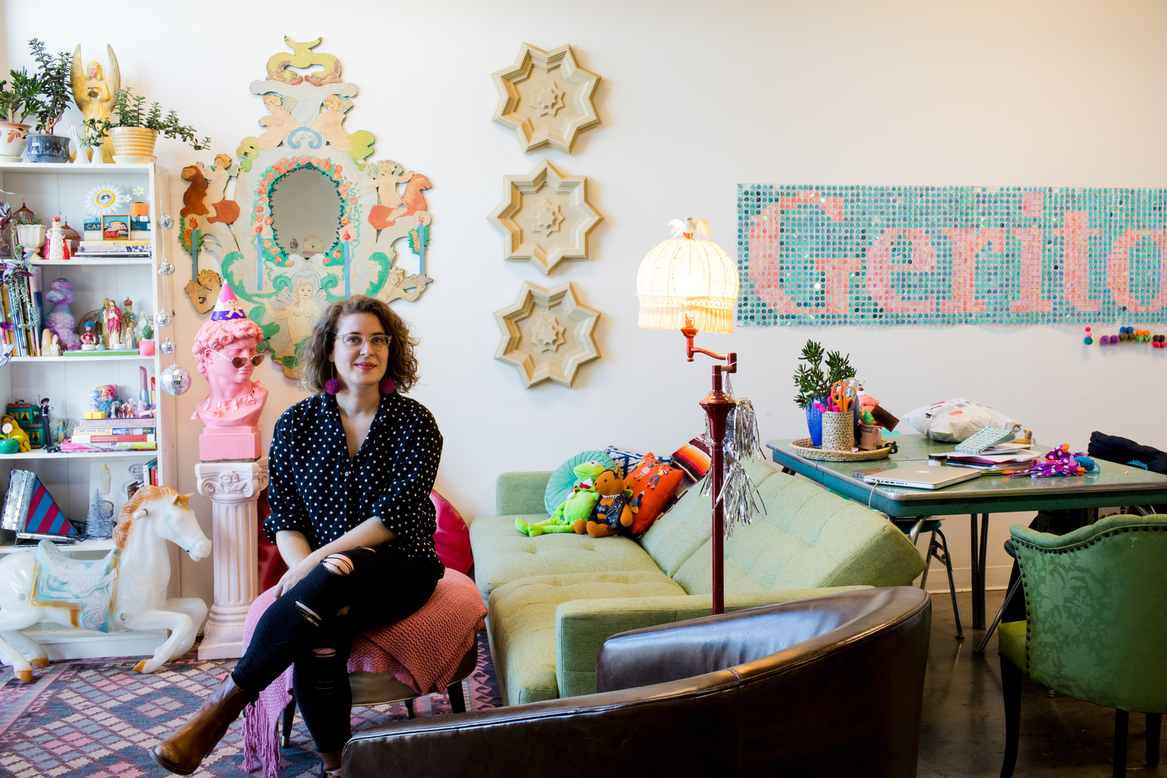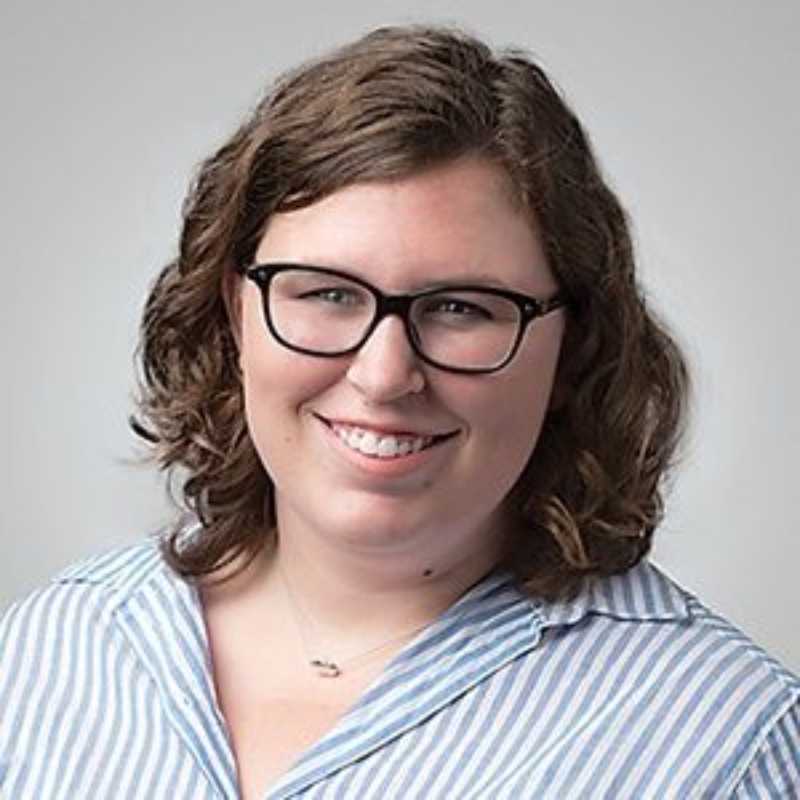
Larger-than-life papier-mâché lipstick tubes, couches and chairs, food items, and massive award ribbons adorn the main gallery space at the Creative Alliance, showcasing more than a decade of work by Alice Gadzinski, who had a studio there until her untimely passing in the spring of 2018 at age 30.
While undergoing cancer treatment throughout the past year, she was just as prolific as ever—experimenting with new sculptures and found-object assemblages, and conducting classes at the Maryland Institute College of Art (her alma mater) and the American Visionary Art Museum. She was also a resident artist at Montgomery College, where she gave talks and exhibited her collaborative installation “Supermarket.”
In the days leading up to the December 7 opening of Haute Glue (a play on words and nod to Gadzinki’s love of using a hot glue gun to craft her work), friends and family gathered at the Creative Alliance to help install the work—and, in some cases, repair it, as papier-mâché is not the most durable material.
Though Gadzinski was from Michigan originally, one look at her artwork would lead you to think she’d been Baltimore born and bred. It’s no wonder she found her artistic home here when she relocated to the city to study at MICA and eventually earn her MFA at its Rinehart School of Sculpture.
It’s sparkly, eccentric pop art; it’s fun; it’s an explosion of bright colors combined with oddball vintage thrift-shop finds—think Paper Moon Cafe meets AVAM gift shop (where Gadzinski once worked) meets HonFest. Her body of work epitomizes Baltimore kitsch. As Creative Alliance executive director Gina Caruso puts it: “Alice loved the beauty of artifice.”
While still in Michigan, working toward her BFA in photography at Kendall College of Art and Design in Grand Rapids, she created a series of self-portraits, which she self-colored. It’s not immediately obvious that the photographs are of her. She disguised herself in each one to reveal various fictional characters. In one, she wears a skintight leopard-print dress. In others, she appears more masculine. In each, a different expression, a new outfit, once even a different nose.
The character’s story is often narrated by what Gadzinski chose to include in each frame. She focused on photography and 2-D work as an undergrad, but in retrospect, her natural progression toward sculpture is obvious. In this self-portrait series, which will be shown in Haute Glue, she began incorporating sculptural components into the pieces—a Marlboro cigarette butt that dangles beneath one of the framed photos; a floral arrangement encircles another; plastic figurines, flowers, and candles have been hot-glued on as embellishments.
After moving away from a focus on photography, some of her first sculptural pieces were found-object assemblages, often glued together to create funky little shrines (one adorns the top of a pink and yellow toilet) made of plastic and porcelain figurines and dolls, vintage jewelry, faux flowers, and other decorative odds and ends, often found at thrift shops. One such shrine is devoted to John Waters, whose photo is at its center, which seems like a fitting persona for Gadzinski’s own aesthetic and ideals—to elevate what society deems as ugly, trashy, or junk into something artful and whimsical, revealing its beauty.
Creative Alliance staff who knew her well explain that she loved to show how we glamorize life, using ordinary objects—such as lipstick or a box of chocolates—to show how we covet them and treat them as holy relics.
When Gadzinski began her artist residency at the Creative Alliance in 2016, her studio became an extension of her colorful creations. “She just experimented with absolutely everything,” says Heather Keating, marketing and communications director at Creative Alliance. “Any time we needed something random, we’d go to Alice.” She’d often wear bright turquoise headphones as she worked, surrounded by paints and glitters and tables of collected objects.
“Alice, like her work, was truly magical,” says Brittney Huff, the annual giving manager at Creative Alliance, who became close friends with Gadzinski. “Her studio was like walking into another world, like walking into a Wonka-esque chocolate factory—just with Barbie shoes and massive cardboard candy boxes. Each corner was packed with thrift-store finds, piles of collected ephemera, and works in progress. Her studio was an ever-changing installation in itself, a home that was explicitly Alice.”
As a resident artist, Gadzinski was involved in all aspects of the Creative Alliance. She taught workshops, gave artwork to promote events, and participated in and attended many of the programs there. And she was always supportive of her colleagues and other resident artists.
“Alice was very present when you spent time with her, and she was a thoughtful listener,” says Caruso. “When she was going through her first round of treatment, she smiled bravely through her pain but was also honest about her experience. She wanted others to learn from her experience and never indulged in self-pity. I admired her bravery, her ability to smile, to be compassionate, even when she was dying. While this exhibition is so joyful and affirming, it’s also heartbreaking for us, because it’s a memorial for someone so young and full of life.”
Haute Glue is laid out in such a way as to include a few nooks to showcase small installation pieces, such as the aforementioned “Supermarket” and another called “Pure Joy Every Day” with a couch at its center, resembling a living room, designed by Cole Chickering and George Wylesol. The main gallery exhibit in December was originally planned as a three-person show featuring work by the two artists and Gadzinski. With the change of plans, Chickering and Wylesol created the installation to honor Gadzinski and her style, and they will hold a two-person show in a gallery on the second floor.
The exhibit will also feature photographs, many of which show pieces that didn’t survive, says Gadzinski’s sister, Emily, who has been helping with the show and provided a carload of Gadzinski’s older work from Michigan.
“She would take photos of everything—even things she didn’t like. A lot of the work is broken, so a lot of getting this show ready has been repairing stuff. This piece is held up by a shoelace,” she says, pointing to a piece on a nearby wall. “Alice was just so concerned with the making of the art itself, she’d just work and move on to the next….We’re trying to exhibit her work at other places; that’s my goal—to just keep it going forever. It’s been really sad, but I think she’d want it this way.”
James Cole, busy installing a smaller version of “Supermarket” for Haute Glue, says he felt like a fish out of water when he came from D.C. to Baltimore to study sculpture at MICA, where he met Gadzinski, who was a year ahead of him in the program. She was the first person to invite him to come hang out with a few friends at Clavel, and he became close friends with her from there on out.
“She was kind of a matriarchal figure in the program,” Cole recalls. “She kind of had this ability to make you feel okay. Sometimes I wouldn’t want to go to the studio, but I knew she was there, so I’d go. And when I showed up, she was always there, and when I left, she was still there. I never knew when she slept.”
He recounts times when she went the extra mile to see if he was okay and give him confidence about his work, and the times they’d check out thrift stores together with her fiancé, Mike Benevenia, also an artist.
“She’d find this kitschy, knick-knack stuff, and she’d make it tasteful—and fragile and ephemeral and beautiful,” Cole says. “I think it was a reflection of who she was.”
“She was a friend, and I miss her terribly. We all do,” says Caruso. “But she wouldn’t want us to be sad—and sometimes when I walk into the exhibition space, it’s as if she’s here with us, smiling.”
